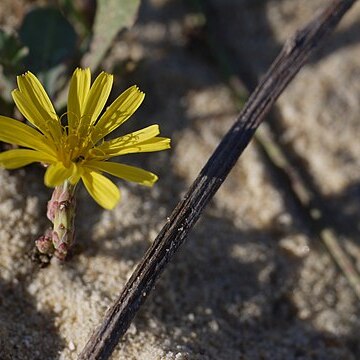Perennial stoloniferous herb; stems prostrate, to 1 m long, glabrous, rooting at the nodes and forming new rosettes there, usually unbranched; rootstock semi-woody, long. Leaves few to many, crowded at stem base, in little fascicles at the nodes, glaucous, sub-succulent, oblanceolate to spatulate, 1-11(-14) cm long, 0.5-2.5(-3) cm wide, base attenuate, subauriculate at the stem, margins entire to denticulate, rarely lobed, apex rounded or obtuse, glabrous; the fascicles often subtended by two broadly ovate bracts. Capitula solitary or few, from the root-crown, also at the nodes; stalks of individual capitula 1-3 cm long, simple, bracteate; involucre narrowly cylindric, 10-15 mm long; phyllaries green, lanceolate, 2-15 mm long, obtuse, glabrous or minutely ciliate distally. Florets 12-20 per capitulum; corolla yellow, tube 8 mm long, ligule 3-7 mm long. Achenes grey-brown, cylindric, 3.5-5 mm long, with slightly spongy ribs; pappus of fine setae 6-10 mm long.
Herb to c. 10 cm high, developing stolons to c. 1 m long, rooting at nodes. Leaves all basal, undivided, to 10 cm long, with l: w ratio c. 3–4, attenuate at base, entire or denticulate; secondary rosettes with much smaller leaves. Capitula solitary at nodes; involucre 4–6 mm diam.; outer bracts c. 8, ovate, c. 3 mm long, with distinct hyaline margin; intermediate bracts c. 6, reaching c. halfway along involucre; inner bracts c. 8, 10–15 mm long. Florets: ligule c. 5 mm long; style hairs pale or darkened. Achenes narrowly obloid, 4–5 mm long, with ribs prominent, brown, glabrous. Pappus caducous, c. 7 mm long, white; bristles scabridulous.
Perennial, prostrate herb, creeping stems up to 1 m long, with milky latex. Leaves in a rosette at crown, fascicled at nodes, spathulate or oblanceolate, long attenuate into a petiole-like base, margins entire or denticulate, glabrous, upper leaves smaller. Capitula ligulate, solitary or few together at tips of short peduncles; involucral bracts imbricate, glabrous. Florets bisexual, corolla yellow. Flowering time Jan.-Apr. (July). Pappus of barbellate setae. Cypselae greyish brown, subfusiform-cylindric, 7-ribbed.
Leaves few to numerous, ± densely crowded at the stem base and also in fascicles at the nodes, the leaf fascicles often subtended by 2 broadly ovate-reniform foliaceous bracts; basal leaves subcoriaceous, up to 11(14)-2.5(3) cm., spathulate to oblanceolate, apices rounded-obtuse, margins subentire to denticulate, rarely also sinuate-dentate to lobed, bases attenuate often subauriculate below; fascicle leaves similar but usually smaller.
Capitula solitary or few from the rootcrown and at the nodes; stalks 1–3 cm. long, simple, bracteate; involucres 10–13 x 3–4 mm. in flowering capitula, up to c. 15 x 5 mm. long in fruiting capitula, narrowly oblong-cylindrical; phyllaries imbricate, increasing uniformly from 3–4 mm. long and ovate on the outside to 13–15 mm. long and lanceolate on the inside, all eventually swollen and corky towards the base.
A fleshy herb. It lies along the ground and is creeping. It keeps growing from year to year. It has a taproot and trailing side roots that bear shoots. The creeping stems are 20-90 cm long. The leaves are in a ring. They are spoon shaped and 3-8 cm long by 1 cm wide. There are deep lobes along the side. The flowers are yellow.
Achenes greyish-brown, 4–5 x 1.5 mm., subfusiform-cylindric, with c. 5 ± inflated spongy ribs; pappus copious of fine, white, minutely barbellate setae 9 mm. long.
Stems up to c. 1.4 m. long, flagelliforrn, usually solitary, simple or sometimes branched, often rooting at the nodes, internodes c. 5–15 cm. long.
Florets 12–20 per capitulum; corollas yellow, c. 15 mm. long, ligule c. 7 mm. long, lorate.
A glabrous perennial herb with a prostrate creeping stem; rootstock semi-woody.

